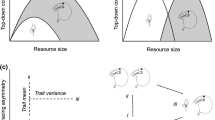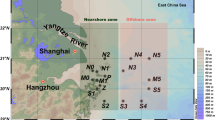Abstract
The sizes of the populations of individual bacterial species diminished following their addition to water from lakes with different trophic levels at temperatures of 5, 10, 15, and 30°C. Some species persisted after their initial reduction in cell numbers, but others were undetectable after 3 to 15 days. The decline of these introduced bacteria was not a result of their inoculation at higher densities than are found in nature. The death of most of the test species was not the result of starvation, abiotic factors, bdellovibrios, or bacteriophages. Despite the presence of lytic bacteria, the lake water did not have lytic activity against the test species. Protozoan predation was a significant factor in the fall in bacterial population sizes because protozoa increased in numbers as the bacterial density fell, the suppression of protozoa led to the elimination or delay of the decline of the bacteria, and the addition of protozoa to lake water in which indigenous protozoa were suppressed produced the same pattern of bacterial elimination as in untreated lake water.
Similar content being viewed by others
References
Acea MJ, Moore CR, Alexander M (1988) Survival and growth of bacteria introduced into soil. Soil Biol Biochem 20:509–515
Barcina I, Arana I, Iriberri J, Egea L (1986) Influence of light and natural microbiota of t Butron River onE. coli survival. Antonie van Leeuwenhoek J Microbiol 52:555–566
Beaver JR, Crisman TL (1989) The role of ciliated protozoa in pelagic freshwater ecosystems. Microb Ecol 17:111–136
Berg CO (1963) Middle Atlantic states. In: Frey DG (ed) Limnology in North America. University of Wisconsin Press, Madison, Wisconsin, pp 191–237
Bloem J, Bär-Gilissen MJB (1989) Bacterial activity and protozoan grazing potential in a stratified lake. Limnol Oceanogr 34:297–309
Carlson RE (1977) A trophic state index for lakes. Limnol Oceanogr 22:361–369
Gurijala KR, Alexander M (1988) Role of sublethal injury in decline of bacterial populations in lake water. Appl Environ Microbiol 54:2859–2861
Henis Y, Gurijala KR, Alexander M (1989) Factors involved in multiplication and survival ofEscherichia coli in lake water. Microb Ecol 17:171–180
Klein TM, Alexander M (1986) Bacterial inhibitors in lake water. Appl Environ Microbiol 52:114–118
Liang LN, Sinclair JL, Mallory LM, Alexander M (1982) Fate in model ecosystems of microbial species of potential use in genetic engineering. Appl Environ Microbiol 44:708–714
McCambridge J, McMeekin TA (1981) Effect of solar radiation and predacious microorganisms on survival of fecal and other bacteria. Appl Environ Microbiol 41:1083–1087
Mitchell R, Yankofsky S (1969) Implication of a marine ameba in the decline ofEscherichia coli in seawater. Environ Sci Technol 3:574–576
Mitchell R, Yankofsky S, Jannasch HW (1967) Lysis ofEscherichia coli by marine microorganisms. Nature (London) 215:891–893
Oglesby RT, Schaffner WR (1978) Phosphorus loadings to lakes and some of their responses. Part 2. Regression models of summer phytoplankton standing crops, winter total P, and transparency of New York lakes with known phosphorus loadings. Limnol Oceanogr 23:135–145
Pace ML (1986) An empirical analysis of zooplankton community size structure across lake trophic gradients. Limnol Oceanogr 31:45–55
Rhodes MW, Kator H (1988) Survival ofEscherichia coli andSalmonella spp. in estuarine environments. Appl Environ Microbiol 54:2902–2907
Riemann B (1985) Potential importance of fish predation and zooplankton grazing on natural populations of freshwater bacteria. Appl Environ Microbiol 50:187–193
Roszak DB, Colwell RR (1987) Survival strategies of bacteria in the natural environment. Microbiol Rev 51:365–379
Scheuerman PR, Schmidt JP, Alexander, M (1988) Factors affecting the survival and growth of bacteria introduced into lake water. Arch Microbiol 150:320–325
Sinclair JL, Alexander M (1984) Role of resistance to starvation in bacterial survival in sewage and lake water. Appl Environ Microbiol 48:410–415
Taylor GT, Pace ML (1987) Validity of eucaryote inhibitors for assessing production and grazing mortality of marine bacterioplankton. Appl Environ Microbiol 53:119–128
Tremaine SC, Mills AL (1987) Thadequacy of the eucaryote inhibitor cycloheximide in studies of protozoan grazing on bacteria at the freshwater-sediment interface. Appl Environ Microbiol 53:1969–1972
Vasconcelos GJ, Swartz RG (1976) Survival of bacteria in seawater using a diffusion chamber apparatusin situ. Appl Environ Microbiol 31:913–920
Vincent JM (1970) A manual for the practical study of root-nodule bacteria. Blackwell Scientific Publications, Ltd., Oxford
Zaidi BR, Stucki G, Alexander M (1988) Low chemical concentration and pH as, factors limiting the success of inoculation to enhance biodegradation. Environ Toxicol Chem 7:143–151
ZoBell CE (1946) Marine microbiology, Chronica Botanica Co. Waltham, MA
Author information
Authors and Affiliations
Rights and permissions
About this article
Cite this article
Gurijala, K.R., Alexander, M. Explanation for the decline of bacteria introduced into lake water. Microb Ecol 20, 231–244 (1990). https://doi.org/10.1007/BF02543879
Received:
Revised:
Issue Date:
DOI: https://doi.org/10.1007/BF02543879




